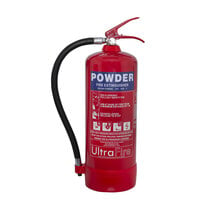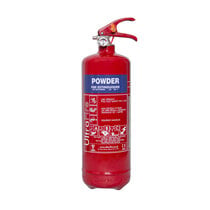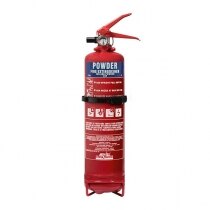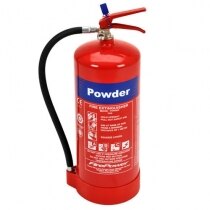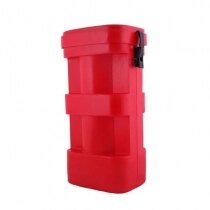-
Contact
Sales & Customer Service
0800 612 6537 support@safelincs.co.uk Live ChatDelivery Enquiries
0800 077 6149 - Resources
Fire & Safety Solutions
CALL OUR TEAM NOW 0800 612 6537
Lines open today 8am - 6pm
Free Delivery
on 100s of Products
Live Chat - Online
Instant help & Advice
Trade Discounts
and exclusive pricing
0% Credit Available
Open an account now
5 Star Customer Feedback
Truck Fire Extinguishers
When you're behind the wheel of a truck or large commercial vehicle, fire safety isn't just about compliance – it's about protecting lives, cargo, and your livelihood. A vehicle fire extinguisher designed for trucks provides the rapid response capability you need when every second counts. What makes truck fire extinguishers different from standard extinguishers? Truck fire extinguishers face unique challenges that standard extinguishers simply can't handle. The constant vibration, temperature fluctuations, and potential for multiple fire types in commercial vehicles demand specialised equipment. These extinguishers feature reinforced mounting systems that withstand the rigours of long-haul journeys. The robust construction prevents damage from road vibrations, sudden stops, and the daily wear and tear that come with commercial vehicle operation. You'll find enhanced pressure gauges that remain accurate despite constant movement, as well as corrosion-resistant components that withstand exposure to diesel fumes, road salt, and harsh weather conditions. The extinguishing agents are chosen explicitly for truck applications. Dry powder extinguishers tackle electrical fires from vehicle systems, fuel fires from diesel spills, and solid material fires from cargo or cab materials. This versatility means that one extinguisher can cover multiple fire risks you might encounter on the road. How do you choose the proper size extinguisher for your truck? Vehicle size and fire risk determine the appropriate extinguisher capacity. Smaller commercial vehicles typically require 1kg or 2kg extinguishers, providing adequate coverage for cab fires or minor engine bay incidents. These compact units fit easily in standard mounting brackets without compromising cab space. Medium trucks and delivery vehicles benefit from 3kg to 4kg extinguishers. This increased capacity handles larger fires and provides an extended discharge time, which is crucial when dealing with cargo fires or more serious engine compartment blazes. Heavy goods vehicles and articulated trucks need 6kg or 9kg extinguishers. These larger units deliver the firepower necessary for substantial cargo fires, extensive engine bay blazes, or multiple fire sources. The extended discharge time allows you to tackle fires methodically, even in challenging conditions. Where should you mount extinguishers in your truck? Proper placement ensures quick access during emergencies. The primary extinguisher should be mounted in the cab, within easy reach of the driver's seat. This location provides immediate access regardless of external conditions and allows the driver to tackle fires before evacuating the vehicle. Secondary extinguishers are most effective when placed near the engine compartment or cargo area, depending on your vehicle's primary fire risks. Engine-mounted extinguishers should be accessible from ground level, allowing you to tackle engine fires safely. Cargo area extinguishers need positioning that provides coverage for the entire load space. Mounting height matters significantly. Extinguishers should be high enough to avoid damage from cargo or debris but low enough for easy removal during emergencies. Most truck extinguishers mount between 1.2m and 1.8m from ground level, providing the right balance of protection and accessibility. Are there legal requirements for truck fire extinguishers? UK regulations require commercial vehicles over 3.5 tonnes to carry appropriate fire extinguishers. The specific requirements vary based on vehicle type, cargo, and operational use. Hazardous goods vehicles are subject to stricter standards, often necessitating the use of multiple extinguishers and specific extinguishing agents. European ADR regulations govern vehicles carrying dangerous goods, mandating specific types and quantities of extinguishers. These requirements ensure your extinguishers match the fire risks associated with your cargo type. Regular inspections and servicing ensure your compliance and guarantee that your extinguishers will function when needed. Annual servicing by certified technicians maintains peak performance and satisfies legal requirements. What maintenance do truck extinguishers need? Monthly visual inspections catch problems early. Check the pressure gauge, examine the mounting bracket for looseness, and inspect the extinguisher body for damage or corrosion. Road conditions can cause gradual degradation that regular checks will identify. Annual professional servicing ensures internal components remain functional. Technicians check internal pressures, examine discharge mechanisms, and verify that the extinguishing agent hasn't degraded. This service catches issues that visual inspections might miss. Replacement becomes necessary when pressure drops, corrosion appears, or damage occurs. Don't attempt repairs on damaged extinguishers – replacement ensures reliable operation when you need it most. How do you use a fire extinguisher on a truck effectively? The PASS technique applies to all fire extinguisher use: Pull the pin, Aim at the base of the fire, Squeeze the handle, and Sweep from side to side. However, truck fires present unique challenges that require adapted techniques. For engine fires, disconnect the battery if it is safely possible and avoid fully opening the bonnet – this can feed oxygen to the fire. Direct the extinguisher through any available gaps, targeting the base of the flames. For cargo fires, approach from upwind when possible and focus on the fire's base rather than the flames themselves. Multiple extinguishers may be necessary for large truck fires. Use the first extinguisher to create a safe path, then deploy additional units to tackle the central fire. Always have an escape route planned and never turn your back on a fire you think is extinguished. Ready to protect your truck and cargo with professional-grade fire extinguishers? Browse our comprehensive range of vehicle fire extinguishers, specifically designed for commercial vehicles, or contact our fire safety experts for personalised advice on the ideal solution for your fleet. Frequently Asked Questions (FAQs) Can I use a standard home fire extinguisher on my truck? Standard home extinguishers lack the robust construction needed for commercial vehicles. Truck extinguishers feature reinforced mounting systems that handle constant vibration, temperature changes, and the demanding conditions of commercial use. They're specifically designed to tackle multiple fire types common in vehicles, including fuel, electrical, and cargo fires. What's the difference between 6kg and 12kg powder extinguishers for trucks? The 6kg extinguisher is suitable for medium-sized trucks and provides excellent coverage for most commercial vehicle fires. The 12kg unit offers extended discharge time and greater capacity, making it ideal for larger trucks, extended fire situations, or vehicles carrying higher fire risks. Both deliver the same multi-purpose ABC powder effectiveness. Do I need special storage boxes for my truck fire extinguishers? Vehicle extinguishers require secure mounting to prevent damage during transport. Storage boxes, such as the Gloria Extinguisher Box, protect your extinguishers from weather, theft, and impact damage. These boxes feature quick-release mechanisms for emergency access and are available in various sizes to match your extinguisher capacity. Are there different regulations for trucks carrying hazardous materials? Yes, ADR regulations set specific requirements based on vehicle weight and cargo type. Trucks under 3.5 tonnes require a minimum total capacity of 4 kg, those between 3.5 and 7.5 tonnes require a minimum of 8kg, and vehicles over 7.5 tonnes require a minimum of 12kg. These regulations ensure adequate fire protection for hazardous cargo transport. How long do truck fire extinguishers last before replacement? Truck extinguishers come with a 10-year warranty and typically last their whole service life with proper maintenance. However, annual professional servicing is crucial to maintain optimal performance and ensure legal compliance. Replace extinguishers immediately if pressure drops, damage occurs, or after any discharge, regardless of age. Understanding outdoor fire extinguisher storage requirements helps maintain your equipment in harsh conditions.
Read more about truck fire extinguishers...
6kg Powder Fire Extinguisher - UltraFire
Often found in warehouses, on commercial trucks and at goods inwards areas, 6kg powders are ideal for fighting a variety of fires.
- Extinguisher Rating: 27A, 183B, C
- 5 Year Warranty
- Kitemarked to BS EN3: 1996
- CE marked and MED approved
2kg Powder Fire Extinguisher - UltraFire
A handy all-rounder, these small powder units are great for commercial vehicles and small outdoor fire risks.
- Extinguisher Rating: 13A, 70B, C
- 5 Year Warranty
- Kitemarked to BS EN3: 1996
- CE marked
3kg Slimline Powder Fire Extinguisher - Jewel Fire Group
Multi-purpose slimline ABC powder fire extinguisher supplied with transport bracket, making it ideal for vans and HGVs.
- Extinguisher Rating: 13A, 55B, C
- 5 year warranty
- CE marked
- Supplied complete with transport bracket
Thomas Glover 9kg Monnex Powder Extinguisher
A super powder fire extinguisher that is the most effective at tackling large flammable liquid fires such as fuel, alcohol and paint. Ideal for petrol stations, fuel depots, airports.
- Extinguisher Rating: 233B, C
- 5 year warranty
- Kitemarked and CE marked
- High performance Monnex Powder with corrosion free valve assembly
Gloria Extinguisher Vehicle Box APD6VBOX
For use on trucks and other vehicles, the Gloria Extinguisher Box is available in two sizes and has a quick release lid for extinguisher access.
- Suitable for 6ltr / 6kg and 9ltr / 9kg extinguishers
- Fitted with a waterproof seal for outdoor use
- Quick release lid for easy access in emergencies
- Suitable for surface mounting or under-hanging fitment
Truck Extinguishers
Truck Extinguishers
If a vehicle carries dangerous goods, it must adhere to ADR regulations (8.1.4.1) which state:
1) if a vehicle weighs less than 3.5 tonnes, it must have a minimum of two extinguishers with a total weight of at least 4kg (usually powder extinguishers, although alternatives are possible) and one of the extinguishers must contain at least 2kg powder.
2) if a vehicle weighs more than 3.5 tonnes but less than 7.5 tonnes, it must have a minimum of two extinguishers with a total weight of at least 8kg and one of the extinguishers must contain at least 6kg powder.
3) if a vehicle weighs more than 7.5 tonnes, it must have a minimum of two extinguishers with a total weight of at least 12kg and one of the extinguishers must contain at least 6kg powder.




















